Rosacea is a common face rash of adults. Rosacea is only a skin condition and is not related to your general health. Rosacea has three stages. In the first stage the face gets red. This redness sometimes merges into the normal variants
of ruddy or blushy complexion types. The redness often persists after cold exposure or after exposure to irritants like soap. With time, small blood vessels develop making the redness more noticeable. Many patients will develop
stinging or burning sensations and the skin will often feel tight. The skin feels like a mild sunburn with smiling, frowning, or squinting. Sometimes this progresses to the point that everything the patient puts on his or her face
stings, burns, and irritates.
In the second stage of rosacea, the redness covers a larger area of the face. Slight swelling, pimples, and pustules develop. This is especially noticeable on the nose, mid-forehead, and chin.
As the condition progresses, prominent facial pores can develop.
The third stage is characterized by swelling and growth of the nose and central facial areas. At times the ears may be involved as well. This can be very disfiguring.
This stage is known as rhinophyma. Most patients do not progress to the third stage of rosacea.
II. Rosacea Causes:
The cause of rosacea is unknown. rosacea is stubborn and often the condition will last for years. Foods or beverages that cause facial flushing, such as alcohol, spicy foods, hot soups, coffee, and tea, may make rosacea temporarily more noticeable. Sunlight is a major trigger factor for rosacea and may be a cause of this condition.
III. Treatment:
Antibiotics such as MetroGel, MetroCream and sulfur preparations applied to the skin one to two times a day work well for many people with rosacea. Retin-A is an effective Rosacea treatment and can decrease the number of small blood vessels. Topical vitamin C creams such as Vitamin C Serum, Obagi Cffectives & LaRoche Posay C will lessen the redness that is caused by rosacea. It should be applied once a day. Use of sunscreen and avoidance of sunlight will help to prevent flares.
Antibiotics taken by mouth are usually an effective Rosacea treatment, and can be used for people not controlled by topical antibiotics. Tetracycline is the most common antibiotic used for treating rosacea. Treatment only controls rosacea. There is no cure for this condition. Most people with this condition need to continue applying Metrogel and Retin-A or taking antibiotics for months to years. Accutane is a drug taken by mouth which is reserved for severe rosacea. Accutane has many side effects and if taken during pregnancy will cause birth defects. Patients taking Accutane must have periodic blood tests and checkups.
The red face of rosacea can often be improved with tunable dye laser treatments. This type of treatment is time consuming and expensive. It is not covered by insurance. Rhinophyma (nose swelling and tissue overgrowth) can be best treated with the CO2 laser or surgical shaving. This is often covered by insurance because it the disease is so disfiguring.
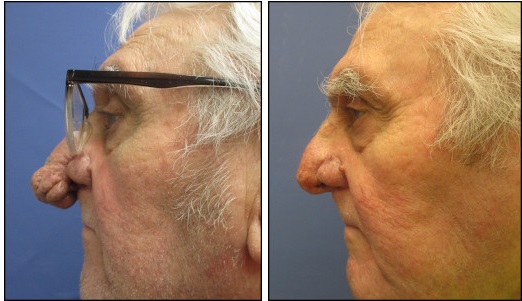
81 year-old male before and 6 weeks after surgical correction of rhinophyma. This bothered him for many years and he was so happy to finally get it corrected. He feels a lot less self-conscious and he's thrilled with the results
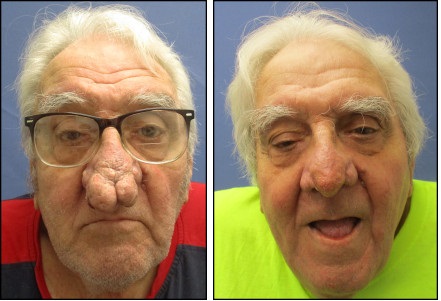
81 year-old male before and 6 weeks after surgical correction of rhinophyma. This lateral side view shows the extent of the rhinophyma deformity.
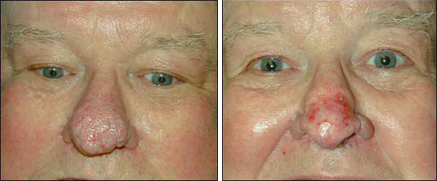
75 year old male before and 3 weeks after correction of rhinophyma. The redness will fade with time.
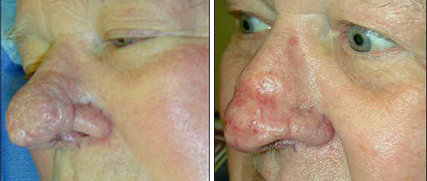
75 year old male before and 3 weeks after correction of rhinophyma. Notice the much improved nasal shape.
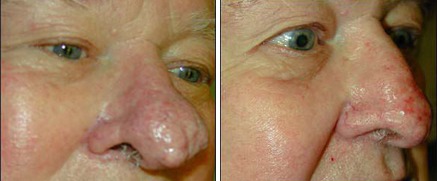
75 year old male before and 3 weeks after correction of rhinophyma. Remember, this is not a rhinoplasty (nasal reshaping operation). When you correct this problem, you are revealing the cartilage and bony shape of the patient's nose.
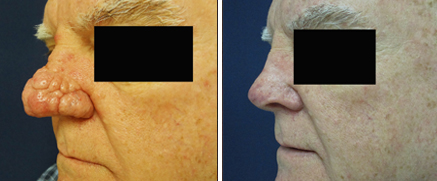
67 year old male before and 6 months after correction of rhynophyma. Notice the much more pleasing contour.
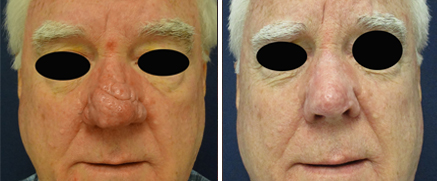
67 year old male before and 6 months after correction of rhynophyma. He was not self-conscious anymore about his nasal appearance. Notice the natural look.
When I first published The 7 Critical Questions to Ask Before Letting Any Surgeon Touch You, I had no idea that it would be so popularly received. Since its publication, this brief guide has helped thousands like you to more safely navigate the world of cosmetic surgery. The 7 Questions have been updated and a bonus section, Applying the 7 Questions, has just been added. Be my guest to read, learn and share.